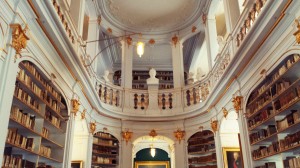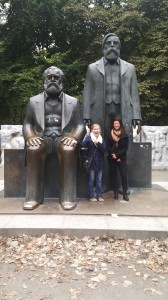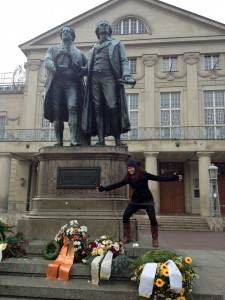After the ending of orientation and the first month of class, students signed up to participate in our once-a-semester-group-excursion to Weimar. The group started off the weekend by enjoying a delicious dinner on Friday night. After a truly enjoyable breakfast, everybody did a guided walking tour of the City of Weimar, that familiarized everybody with the location of the numerous sites everybody set off individually in the afternoon. Equipped with City maps and guideboods (courtesy of the program) students set off to explore whatever served their individual interests best. Some visited the Anna-Amalia Library that was restored after a devastating fire in 2004 to look again as it did at Goethe’s times.
Image Courtesy of Robin Cho, program participant
Some students chose the houses of Goethe and Schiller, others went to the Kirms-Krackow House.
Facing the Biggies: Image Courtesy of Christina Salerno, program participant
Yet others took a walk in the Park an der Ilm, where Goethe wrote the ‘Erlkönig’ after they had explored the fine collection of paintings located in the Weimar Castle (in the background below.)
Image Courtesy of Irene Gonzalez, program participant
And of course, they all took advantage to try either Weimar’s spiciest, hottest, longest Thüringer Bratwurst – or all three kinds offered at the market place before the Rathaus. In the afternoon, Cafés beckoned our attention – there were just too many delicious cakes to be sampled.
At night, some of the students saw ‘Falstaff’ at the Weimar Nationaltheater, where Goethe and Schiller remain to be honored as Germany’s most prominent writers of the 18th Century.
Image Courtesy of Kayla Gulec, Program Participant. (Nov. 10, 1759 is Schiller’s birthday – that’s why you see all the wreaths.)
Others went to the Theater im Gewölbe to see a performance of ‘Goethes Glanz und Schillers Glorie’.
On Sunday morning, we took the bus to the Buchenwald Memorial located on the Ettersberg. A movie and an audio tour of the premises explained what happened at this concentration camp. Impressions gained fed conversations that lasted longer than the trip that ended with students returning to either Mainz or Berlin in the late afternoon.
All tickets and travel-costs were fully sponsored by the progam.
Student Contribution:
Attempt of thought processing after our visit to Buchenwald, by Irene Gonzalez, program participant
The Sunday visit to Buchenwald was my first time exposed to such intense evidence of human suffering, and I have to recognize that it was a shocking experience. It is intense, overwhelming, full of contradictions, frustrations, fast moving thoughts that crash against a wall and are paralyzed in the presence of intense emotions… I think that words really fail to describe the experience and all the feelings and thoughts that came with it, but I find it necessary to write part of this thought-processing down, allowing for the reasoning of what has been seen and experienced, as we try to understand the meaning of it all.
Already on the buss drive from Weimar to Buchenwald, the upcoming shock and experience was starting to impregnate the ambiance; we became quieter as we were approaching the site. We just kept looking outside of the window, into a forest bathed on a dense fog, and it seemed like nature was preparing us for what was coming next.
After our arrival to Buchenwald, we watched a documentary, which illustrated the history of the place and National Socialism in Weimar. One of the facts, which I found most surprising, was how the vicinity in Weimar, only 8 km. away, did not know of the atrocities and thousands of deaths that took place here. “How is that even possible?!”, was my initial reaction. Then I realized that this fog which we had seen from the buss, becoming thicker and thicker as we headed up the hill, was probably a good metaphor to explain the case: the fog is there, it comes from nature, it is always surrounding us regardless of whether we want it or not. And yes, it presents an impediment to how far our eyes can reach, but it seems harmless, it is not attacking us as violently as maybe the wind, rain or snow can do – I see in the machinery of the Nazi Regime something like this fog for the inhabitants of Weimar: they could not feel the violence against themselves and it was just an impediment to their view; a view which could not reach the site up the hill until everything was over.
We spent around 4 hours in Buchenwald, time to walk around the site, visit the exhibitions, and enter into those spaces that still remain in place. It does not matter how many times I may have read and learnt about this part of history, the visit was more powerful than anything I had seen before. And it was so, that during these hours and the hours latter I just had an intense stomachache produced by the intensity of emotions in the place.
With every new step, every new picture, every new story… just more questions kept pilling up in my head: how is any human being capable of inflicting so much pain in other human beings? How are the same minds, which are able to create art and beauty, capable of designing a machinery and system of extermination and suffering? How intense can the psychology of power be? Why do we focus on the differences and what separates “us” from “the other”, instead of looking at the similarities? Where is the source of discrimination based on religion, race, or sexual orientation? What is the human being capable of bearing? Why did it take so long until this massacre came to an end? If we have this site still in place, with all sorts of evidence and testimonials, how is it possible that some people still deny its occurrence? How is it possible that people still identify with forms of extremist thinking? How is it possible that we are still allowing massacres in our world today?
Questions and questions, sadly and frustratingly without an answer, kept adding up with every step along the way.
Visiting places like the crematory or the imprisonment cells was simply heart breaking, and in many instances, I had to move my eyes away faster than what I expected.
After leaving Buchenwald, on the bus back to Weimar, more questions kept coming into my head, but this time I was trying to process them in a way in which I could find a possible answer. And the process continued for hours, and I tried my best through talking, and writing, and thinking… And I guess all my thoughts summarized into: HOW can we prevent this from happening ever again?
With the evidence that atrocities and discrimination are still a reality in our present days, there has obviously been no complete learning from this experience. As of now, I have come to the same conclusion that I have always found in philosophical, political or historical debates. What is the key? – EDUCATION
– Education to learn from the past and avoid the same mistakes.
– To provide everyone with the tools that they need to make conscious decisions
– To provide everyone with the possibility of having a good future and therefore avoiding the fall into desperate solutions
– To allow critical thinking and value judgment in all aspects of life
– To prevent the fall into periods of crisis like the one which allowed Hitler to achieve power
– To provide everyone with a voice that has the capacity to demand what is right
– To empower everyone with a sense of dignity, which will prevent them from falling under the orders of someone else who is just louder than them
– …
In conclusion, I view EDUCATION as the indispensable tool that allows for individual and societal advancement. Of course there is still a long way to go to achieve the Millenium Goal of “universal education”, but trying to draw a positive thought after the sad and emotional experience in Buchenwald, we must keep working on making education for everyone a reality if we hope to make things different. There lies the challenge.




